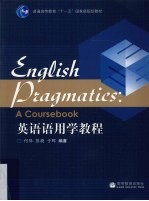图书介绍
英语语用学教程PDF|Epub|txt|kindle电子书版本网盘下载

- 何伟,彭漪,于晖编著 著
- 出版社: 北京:高等教育出版社
- ISBN:9787040276749
- 出版时间:2010
- 标注页数:164页
- 文件大小:73MB
- 文件页数:179页
- 主题词:英语-语用学-高等学校-教材
PDF下载
下载说明
英语语用学教程PDF格式电子书版下载
下载的文件为RAR压缩包。需要使用解压软件进行解压得到PDF格式图书。建议使用BT下载工具Free Download Manager进行下载,简称FDM(免费,没有广告,支持多平台)。本站资源全部打包为BT种子。所以需要使用专业的BT下载软件进行下载。如BitComet qBittorrent uTorrent等BT下载工具。迅雷目前由于本站不是热门资源。不推荐使用!后期资源热门了。安装了迅雷也可以迅雷进行下载!
(文件页数 要大于 标注页数,上中下等多册电子书除外)
注意:本站所有压缩包均有解压码: 点击下载压缩包解压工具
图书目录
1 Background and definitions1
1.1 Background of pragmatics1
1.2 Definitions of pragmatics2
1.3 Component vs.perspective4
1.4 Uses of pragmatics6
1.5 Aims of pragmatics8
1.6 Summary and further reading9
Questions for discussion10
2 Deixis and reference11
2.1 Definition of deixis11
2.2 Types of deixis14
2.2.1 Person deixis14
2.2.2 Spatial deixis16
2.2.3 Temporal deixis18
2.2.4 Discourse deixis19
2.2.5 Social deixis21
2.3 Definition of reference22
2.4 Referential and attributive usages of referring expressions23
2.5 The role of context in identifying referents24
2.6 The role of co-text in identifying referents24
2.7 The role of anaphora,cataphora and zero anaphora in maintaining reference25
2.8 Summary and further reading27
Questions for discussion27
3 Presupposition29
3.1 Definition of presupposition30
3.2 Distinguishing presupposition from entailment31
3.3 Types of presupposition34
3.3.1 Existential presupposition34
3.3.2 Lexical presupposition34
3.3.3 Structural presupposition35
3.3.4 Factive presupposition35
3.3.5 Non-factive presupposition36
3.3.6 Counter-factual presupposition37
3.4 Problematic properties37
3.4.1 Defeasibility37
3.4.2 Projection problem39
3.5 Summary and further reading41
Questions for discussion42
4 Conversational implicature(Ⅰ)43
4.1 Definition of implicature43
4.2 The cooperative principle44
4.3 The four conversational maxims45
4.3.1 Observing the maxims45
4.3.2 Non-observance of the maxims46
4.4 Types of implicature54
4.4.1 Conventional implicature54
4.4.2 Conversational implicature55
4.5 Properties of conversational implicature57
4.5.1 Cancelability57
4.5.2 Non-detachability58
4.5.3 Calculability59
4.5.4 Non-conventionality60
4.6 Summary and further reading61
Questions for discussion61
5 Conversational implicature(Ⅱ)63
5.1 The politeness principle63
5.2 The six main maxims65
5.2.1 The tact maxim65
5.2.2 The generosity maxim67
5.2.3 The approbation maxim68
5.2.4 The modesty maxim69
5.2.5 The agreement maxim70
5.2.6 The sympathy maxim71
5.3 The relationship between the politeness principle and the cooperative principle71
5.4 Problems with Leech's politeness principle74
5.5 Summary and further reading74
Questions for discussion75
6 The relevance-theoretic framework76
6.1 The origin of relevance theory76
6.2 The principle of relevance78
6.2.1 The notion of relevance78
6.2.2 The cognitive and the communicative principles of relevance80
6.3 The notion of context83
6.3.1 Cognitive environment83
6.3.2 Context selection84
6.4 Relevance-guided comprehension85
6.4.1 A comprehension heuristic85
6.4.2 Implicature vs.explicature86
6.5 Constraints on relevance88
6.5.1 Conceptual and procedural encoding88
6.5.2 Types of contextual effects90
6.6 Summary and further reading94
Questions for discussion95
7 Speech act theory96
7.1 Definition of speech act96
7.2 Composition of a speech act98
7.3 Recognition of illocutionary force99
7.3.1 Definition of illocutionary force99
7.3.2 Illocutionary force indicating devices100
7.3.3 Felicity conditions101
7.4 Classification of speech acts102
7.4.1 Approaching the functions of speech acts102
7.4.2 Approaching the performance of speech acts106
7.5 Beyond speech act theory:speech events109
7.6 Summary and further reading110
Questions for discussion111
8 Conversation analysis112
8.1 Introduction112
8.2 Theoretical preliminaries113
8.3 Turn-taking organization115
8.3.1 Turn constructional unit116
8.3.2 Turn-allocation component117
8.3.3 Turn-taking rules118
8.4 Adjacency pairs121
8.4.1 Insertion sequence122
8.4.2 Conditional relevance124
8.5 Preference organization126
8.5.1 Preferred vs.dispreferred second126
8.5.2 Agreeing and disagreeing with assessments129
8.5.3 Repair133
8.6 Pre-sequence136
8.6.1 Pre-announcements138
8.6.2 Pre-requests139
8.6.3 Summons-answer140
8.7 Summary and further reading142
Questions for discussion143
9 Conclusions145
9.1 Approaches to pragmatics145
9.2 The multidisciplinary nature of pragmatics146
9.2.1 Pragmatics and branches of micro-linguistics147
9.2.2 Pragmatics and interdisciplinary fields149
9.3 The dynamic perspective of pragmatics150
9.3.1 The dynamics of communication151
9.3.2 The construction of meaning153
9.4 The application of pragmatics155
9.5 Summary and further reading157
Questions for discussion158
References159